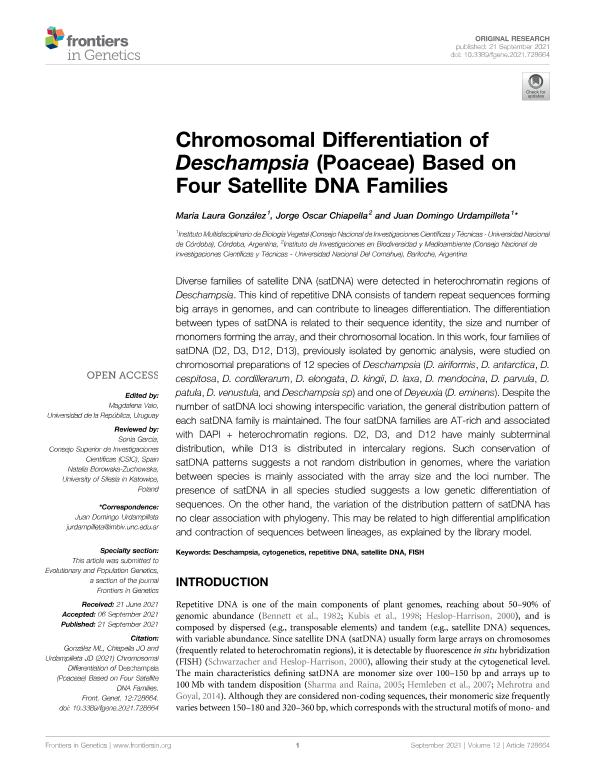Artículo
Chromosomal Differentiation of Deschampsia (Poaceae) Based on Four Satellite DNA Families
Fecha de publicación:
09/2021
Editorial:
Frontiers Media
Revista:
Frontiers in Genetics
e-ISSN:
1664-8021
Idioma:
Inglés
Tipo de recurso:
Artículo publicado
Clasificación temática:
Resumen
Diverse families of satellite DNA (satDNA) were detected in heterochromatin regions of Deschampsia. This kind of repetitive DNA consists of tandem repeat sequences forming big arrays in genomes, and can contribute to lineages differentiation. The differentiation between types of satDNA is related to their sequence identity, the size and number of monomers forming the array, and their chromosomal location. In this work, four families of satDNA (D2, D3, D12, D13), previously isolated by genomic analysis, were studied on chromosomal preparations of 12 species of Deschampsia (D. airiformis, D. antarctica, D. cespitosa, D. cordillerarum, D. elongata, D. kingii, D. laxa, D. mendocina, D. parvula, D. patula, D. venustula, and Deschampsia sp) and one of Deyeuxia (D. eminens). Despite the number of satDNA loci showing interspecific variation, the general distribution pattern of each satDNA family is maintained. The four satDNA families are AT-rich and associated with DAPI + heterochromatin regions. D2, D3, and D12 have mainly subterminal distribution, while D13 is distributed in intercalary regions. Such conservation of satDNA patterns suggests a not random distribution in genomes, where the variation between species is mainly associated with the array size and the loci number. The presence of satDNA in all species studied suggests a low genetic differentiation of sequences. On the other hand, the variation of the distribution pattern of satDNA has no clear association with phylogeny. This may be related to high differential amplification and contraction of sequences between lineages, as explained by the library model.
Palabras clave:
CYTOGENETICS
,
DESCHAMPSIA
,
FISH
,
REPETITIVE DNA
,
SATELLITE DNA
Archivos asociados
Licencia
Identificadores
Colecciones
Articulos(IMBIV)
Articulos de INST.MULTIDISCIPL.DE BIOLOGIA VEGETAL (P)
Articulos de INST.MULTIDISCIPL.DE BIOLOGIA VEGETAL (P)
Articulos(INIBIOMA)
Articulos de INST. DE INVEST.EN BIODIVERSIDAD Y MEDIOAMBIENTE
Articulos de INST. DE INVEST.EN BIODIVERSIDAD Y MEDIOAMBIENTE
Citación
González, María Laura; Chiapella, Jorge Oscar; Urdampilleta, Juan Domingo; Chromosomal Differentiation of Deschampsia (Poaceae) Based on Four Satellite DNA Families; Frontiers Media; Frontiers in Genetics; 12; 728664; 9-2021; 1-12
Compartir
Altmétricas




